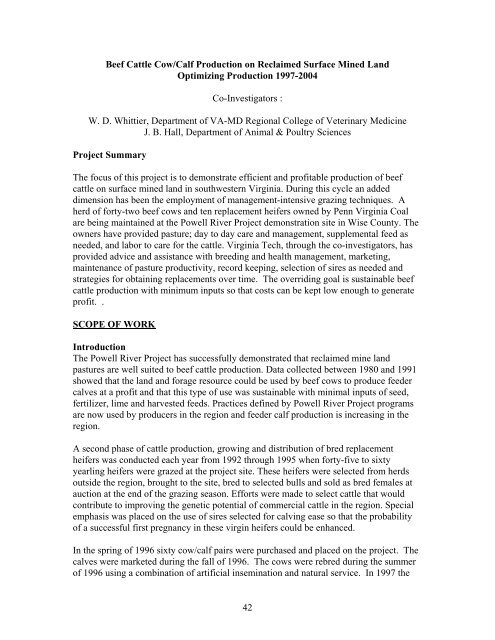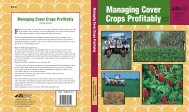Beef Cattle/Calf Production on Reclaimed Surface Mined Land ...
Beef Cattle/Calf Production on Reclaimed Surface Mined Land ...
Beef Cattle/Calf Production on Reclaimed Surface Mined Land ...
Create successful ePaper yourself
Turn your PDF publications into a flip-book with our unique Google optimized e-Paper software.
<str<strong>on</strong>g>Beef</str<strong>on</strong>g> <str<strong>on</strong>g>Cattle</str<strong>on</strong>g> Cow/<str<strong>on</strong>g>Calf</str<strong>on</strong>g> <str<strong>on</strong>g>Producti<strong>on</strong></str<strong>on</strong>g> <strong>on</strong> <strong>Reclaimed</strong> <strong>Surface</strong> <strong>Mined</strong> <strong>Land</strong>Optimizing <str<strong>on</strong>g>Producti<strong>on</strong></str<strong>on</strong>g> 1997-2004Co-Investigators :W. D. Whittier, Department of VA-MD Regi<strong>on</strong>al College of Veterinary MedicineJ. B. Hall, Department of Animal & Poultry SciencesProject SummaryThe focus of this project is to dem<strong>on</strong>strate efficient and profitable producti<strong>on</strong> of beefcattle <strong>on</strong> surface mined land in southwestern Virginia. During this cycle an addeddimensi<strong>on</strong> has been the employment of management-intensive grazing techniques. Aherd of forty-two beef cows and ten replacement heifers owned by Penn Virginia Coalare being maintained at the Powell River Project dem<strong>on</strong>strati<strong>on</strong> site in Wise County. Theowners have provided pasture; day to day care and management, supplemental feed asneeded, and labor to care for the cattle. Virginia Tech, through the co-investigators, hasprovided advice and assistance with breeding and health management, marketing,maintenance of pasture productivity, record keeping, selecti<strong>on</strong> of sires as needed andstrategies for obtaining replacements over time. The overriding goal is sustainable beefcattle producti<strong>on</strong> with minimum inputs so that costs can be kept low enough to generateprofit. .SCOPE OF WORKIntroducti<strong>on</strong>The Powell River Project has successfully dem<strong>on</strong>strated that reclaimed mine landpastures are well suited to beef cattle producti<strong>on</strong>. Data collected between 1980 and 1991showed that the land and forage resource could be used by beef cows to produce feedercalves at a profit and that this type of use was sustainable with minimal inputs of seed,fertilizer, lime and harvested feeds. Practices defined by Powell River Project programsare now used by producers in the regi<strong>on</strong> and feeder calf producti<strong>on</strong> is increasing in theregi<strong>on</strong>.A sec<strong>on</strong>d phase of cattle producti<strong>on</strong>, growing and distributi<strong>on</strong> of bred replacementheifers was c<strong>on</strong>ducted each year from 1992 through 1995 when forty-five to sixtyyearling heifers were grazed at the project site. These heifers were selected from herdsoutside the regi<strong>on</strong>, brought to the site, bred to selected bulls and sold as bred females ataucti<strong>on</strong> at the end of the grazing seas<strong>on</strong>. Efforts were made to select cattle that wouldc<strong>on</strong>tribute to improving the genetic potential of commercial cattle in the regi<strong>on</strong>. Specialemphasis was placed <strong>on</strong> the use of sires selected for calving ease so that the probabilityof a successful first pregnancy in these virgin heifers could be enhanced.In the spring of 1996 sixty cow/calf pairs were purchased and placed <strong>on</strong> the project. Thecalves were marketed during the fall of 1996. The cows were rebred during the summerof 1996 using a combinati<strong>on</strong> of artificial inseminati<strong>on</strong> and natural service. In 1997 the42
decisi<strong>on</strong> was made to decrease the herd to approximately 30 cows as additi<strong>on</strong>al mining inthe area usurped a significant proporti<strong>on</strong> of the grazing lands. These cattle have grazedthe existing pastures at the dem<strong>on</strong>strati<strong>on</strong> site al<strong>on</strong>g with the purchase of some hay andcorn for supplemental winter feeding. Steps have been taken to make full use of theforage resources available <strong>on</strong> site for year round feeding of the cow herd. Fencing,handling facilities, water supplies and other essential inputs are available <strong>on</strong> site or havebeen enhanced as needed.The operati<strong>on</strong> of this cow/calf program has sufficient scale to generate income and tomake efficient use of resources and labor. It is comparable in scope to many similaroperati<strong>on</strong>s that have been established in the regi<strong>on</strong> due in part to prior programs of thePRP. The intent of this report is to dem<strong>on</strong>strate the most cost effective and profitablemanagement strategies for operati<strong>on</strong> of a beef cow-calf herd <strong>on</strong> reclaimed surface minedland and to dem<strong>on</strong>strate ways to enhance the sustainability and profitability of such anenterprise. Techniques for management-intensive grazing have been employed.Justificati<strong>on</strong> and ObjectivesLivestock producti<strong>on</strong> has been dem<strong>on</strong>strated to be a productive use of reclaimed land. Inrecent years, more operators have obtained use of reclaimed land by lease or other meansand the number of beef cattle in the coal producing counties has increased as moreoperators have recognized ec<strong>on</strong>omic opportunity. The bred heifer project of the PRPaided in this expansi<strong>on</strong> and many of the heifers have g<strong>on</strong>e into herds in Wise, Dickens<strong>on</strong>and Scott counties. However, it appears that there are opportunities to enhanceprofitability of these operati<strong>on</strong>s by making greater use of the basic forage resource and byemploying the best management practices available to beef producers. A primaryexample of such strategies is the reduced use of harvested feed such as hay by bettermanagement of the forage resource to provide near year-round grazing. Also, the qualityof the animals can be enhanced by use of improved genetics. Marketing procedures havebeen improved and greater use of proven management practices and record keeping isbeneficial. The employment of most or all of these strategies and procedures has been theobjective of this dem<strong>on</strong>strati<strong>on</strong> project. The project has the additi<strong>on</strong>al benefit to the coalindustry and regi<strong>on</strong> by showing that reclaimed land can make an important c<strong>on</strong>tributi<strong>on</strong>to the ec<strong>on</strong>omic life of the community. We are now in the phase of the cattle cycle wherenumbers are low and prices are quite high. This is a time when significant expansi<strong>on</strong> ofbeef cattle producti<strong>on</strong> might occur in the area as opportunities for profitability areperceived.Methods and ProceduresForty-two beef cows and their calves are currently in place at the project site. Tenreplacement heifers were weaned and begun development off site over the early winter,then returned to the site to be bred this seas<strong>on</strong>. Co-investigators working with PennVirginia Coal pers<strong>on</strong>nel have developed a management and breeding plan for the herdwhich is being grazed at present. The cows and calves are grazed <strong>on</strong> the propertythroughout most of the year with <strong>on</strong>ly supplemental feeding when there is snow cover.Calves are sold about November 1. Calving commences about March 1.43
ResultsFigures 1- 3 dem<strong>on</strong>strate the progress made in producti<strong>on</strong> of cattle from 1997 through2003:Figure 1. Number of females (cows and replacement heifers) grazedeach summer.6052504742Number of females403020282731361001997 1998 1999 2000 2001 2002 2003Year44
Figure 2.Changes in weaning Weights, Powell River Project,1997-2003.Weaning Wt. (lbs, steers adj. to 240 days)600500400300200100449476465516528 53555701997 1998 1999 2000 2001 2002 2003YearFigure 3. Percent of cows exposed to breeding in prior year weaning a calf thesubsequent year (cows culled for age, unsoundness or producti<strong>on</strong> excluded).102100100Percent cows weaning a calf989694929093979294989188861997 1998 1999 2000 2001 2002 2003Year45
These figures dem<strong>on</strong>strate a clear trend in optimizing producti<strong>on</strong> of beef <strong>on</strong> reclaimedstrip-mined land. On the same acreage female numbers have been increased, weaningweights have been augmented and although there is some variati<strong>on</strong>, reproductiveperformance has been maintained.Major approaches to achieving these ends have included:- Management intensive grazing principles have been implemented.- A herd health program to minimize disease losses has been further refined- By use of artificial inseminati<strong>on</strong> and natural service, cows have been bred to sires thathave the potential to maximize growth and marketability of the end product - weanedsteer and heifer calves.- A program of fencing, fertilizati<strong>on</strong>, overseeding and c<strong>on</strong>trolled grazing has beeninstalled to maximize efficient forage producti<strong>on</strong> and utilizati<strong>on</strong>.- Water facilities have been improved to provide for high quality fresh water for cowsand calves.SummaryThis dem<strong>on</strong>strati<strong>on</strong> is a highly visible example to area producers of what can beaccomplished using available informati<strong>on</strong> in the most effective manner. It is hoped thiswill lead other producers to adopt techniques to enhance the productivity of theiroperati<strong>on</strong>s.46
















